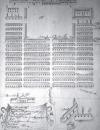Resumen
La acción misionera que la Compañía de Jesús empezó enAmérica en el siglo 'f:V involucrando distintos grupos nativos,fue reconocida como un suceso. Su cumbre fue alcanzadaen la Provincia Jesuítica del Paraguay donde, con los indiosGuaraní, se llevó a cabo una peculiar experiencia desde elpunto de vista socio-económico-cultural, que provocó grandesdiscusiones y polémicas durante siglos.En lo que se refiere a la arquitectura y al ordenamientourbano, esta ocurrencia puede ser considerada como un auténticopatrón, hoy conocido como "tipología urbana misionera".Untipo especial de asentamiento humano que se reprodujoen un enorme territorio, creando una red de pueblos quepuede ser vista como ejemplo de un sistema real basado enlos principios del barroco.En este espacio de exclusión se implantó la reducción deSan Miguel Arcángel, cuyos remanentes fueron declaradospor la UNESCcOomo Patrimonio Mundial. En este estudio, escogimosesta reducción como arquetipo en la búsqueda de respuestasque logren contribuir a desvelar -a partir de la visión del arquitecto- el origen, las influencias y las característicasde este sistema; las relaciones de forma, función y significadode los elementos espaciales producidos, y las prácticassociales allí adoptadas.La revista Apuntes se encuentra registrada bajo la licencia Creative Commons Reconocimiento 4.0 Internacional. Por lo tanto, esta obra se puede reproducir, distribuir y comunicar públicamente en formato digital, siempre que se reconozca el nombre de los autores y a la Pontificia Universidad Javeriana. Se permite citar, adaptar, transformar, autoarchivar, republicar y crear a partir del material, para cualquier finalidad (incluso comercial), siempre que se reconozca adecuadamente la autoría, se proporcione un enlace a la obra original y se indique si se han realizado cambios. La Pontificia Universidad Javeriana no retiene los derechos sobre las obras publicadas y los contenidos son responsabilidad exclusiva de los autores, quienes conservan sus derechos morales, intelectuales, de privacidad y publicidad.
El aval sobre la intervención de la obra (revisión, corrección de estilo, traducción, diagramación) y su posterior divulgación se otorga mediante una licencia de uso y no a través de una cesión de derechos, lo que representa que la revista y la Pontificia Universidad Javeriana se eximen de cualquier responsabilidad que se pueda derivar de una mala práctica ética por parte de los autores. En consecuencia de la protección brindada por la licencia de uso, la revista no se encuentra en la obligación de publicar retractaciones o modificar la información ya publicada, a no ser que la errata surja del proceso de gestión editorial. La publicación de contenidos en esta revista no representa regalías para los contribuyentes.


